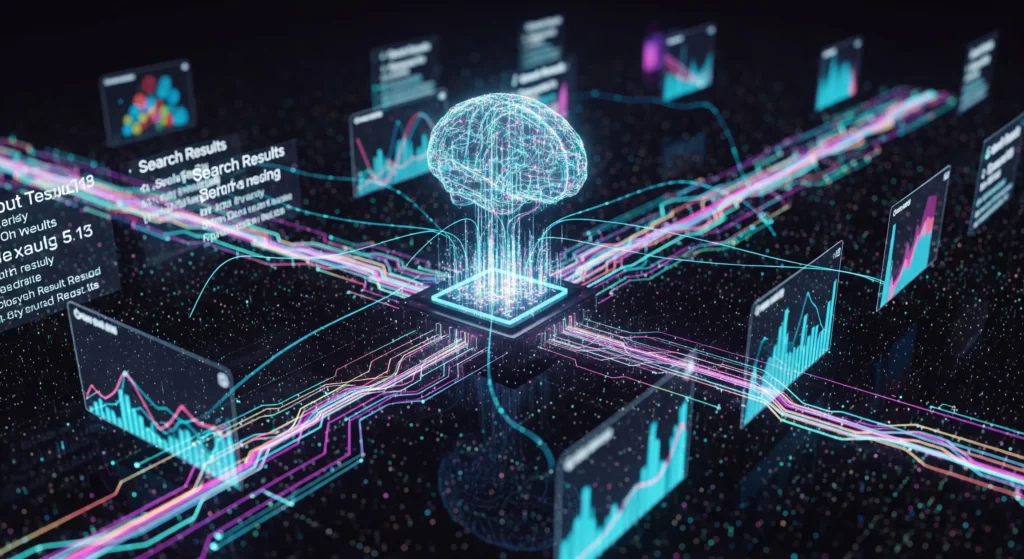The construction of a generative AI solution has numerous trade-offs and cost elements. Generative AI projects may cost tens of thousands or millions of dollars, based on variables. Indeed, according to a recent industry article, simple generative AI applications can range in cost between $20,000 and $150,000. And complex custom applications can cost between $100,000 and $500,000 and above. Budgeting is difficult with such broad ranges without a detailed estimate. Organizations should therefore take into account all the inputs; raw data collection to continued use of clouds to know the total project costs.

Key Components of Building a Generative AI
Creating any generative AI system requires assembling several core components. Each brings its own costs and challenges.
Data Collection
The generative models run on high-quality data. Learning big data can be costly and time-intensive. The companies might have to buy proprietary data, have annotators label the content, or invest in data cleaning and storage. It has been found out that the cost of data quality and volume are significant. Additionally, data acquisition, cleaning, and preparation can take up a significant part of the budget. As an illustration, acquisition of specialized datasets may cost between 30K and 100K or higher when acquiring large volumes. A generative model cannot learn without good data, and thus skimping in this case tends to produce poor results.
Model Development
Another significant cost is to design and train the AI model. Experts in AI, data scientists, and engineers will have to design the model (e.g. neural network layers, algorithms) and conduct experiments. The Research and Development (R&D) costs are inflated by their salaries and fees. Actually, AI talent is hard to find, and domain experts may be recruited at will at $50K150K of the project budget. The more innovative or specialized the solution, the greater the amount of R&D work is required. As an example, custom neural architecture development or adaptation may contribute to the bill by $40K 150K. All in all, R&D and human expertise are regularly mentioned as huge line items in generative AI budgets.
Computational Resources
Training generative models demands huge compute power. Model training often requires dozens or hundreds of high-end GPUs or cloud-based accelerators running for weeks. Such hardware is very costly. For example, industry analysis shows that training a large language model (LLM) like GPT-3 required between $0.5–$4.6 million in compute costs. Even renting cloud GPUs can add up: an AWS P3 instance might cost $3–$24 per hour depending on type, so training for days can reach tens of thousands. Many companies also pay monthly for cloud hosting, data storage, and GPU usage. As IBM reports, AI compute costs are rising rapidly – one study projected average computing costs up 89% by 2025, largely driven by generative AI workloads. In short, infrastructure and hardware are a heavy cost driver in any generative AI project.
Software and Tools
This category covers software licenses, AI frameworks and development tools. Most developers of generative AIs use open-source frameworks such as TensorFlow or PyTorch (both free). Though commercial APIs or platforms may be used in enterprise applications. As an example, when a team relies on a managed service (e.g. OpenAI or Azure AI), it has to pay subscription or per-use fees. Even custom tooling (advanced annotation software or visualization tools) may be charged. These expenses are relatively low when compared to data or hardware, but they accumulate. Depending on the size, companies ought to plan the required software licenses and cloud services fees that may cost a few thousand to tens of thousands of dollars per year.

How Much Does It Cost to Build a Generative AI?
The overall price of generative AI is estimated based on the complexity of the project. In the case of a simple generative AI application, like a simple content generator or chatbot, costs can begin in the range of $20,000 – $60,000. Applications with more features and custom models usually fall between the 100,000 and 300,000 price range. At the top end, a complete generative AI platform with advanced features can cost easily over $500,000 or more. Simple generative AI projects are more likely to be in the range of 20K-150K, whereas complex ones may go up to 100K-500K, as one of the industry analyses has discovered.
In extremely large-scale instances, the figures are even more elevated. A detailed cost breakdown estimates the total initial development costs to be about $600K -1.5M on a full scale solution. This is all the major components (research, data, infrastructure, deployment, etc.). It should be mentioned that these are only estimates; the actual costs are diverse. Smaller projects can spend much less whereas bleeding-edge R&D or enterprise implementations will spend a lot more. More importantly, firms should also budget on the continuous costs, once deployed, a generative AI system can cost hundreds of thousands annually to maintain (in terms of cloud hosting, updates, and support).
Breakdown: Key Factors Influencing Generative AI Costs
Several key factors drive up the price of building generative AI:
Scope and Complexity
A basic application (e.g. a text generator based on templates) is much cheaper than a complex application (such as an AI based codewriter or a realistic video generator). Increased complexity implies increased research, customization and testing. To illustrate this, the addition of more sophisticated functionality such as the ability to know the context of the user or create high-resolution images increases the cost and development time.
Research & Expertise
The most advanced generative AI can require the best talent. The budget is greatly inflated by hiring AI researchers, data scientists, and engineers. Their working hours are costly. Some cost breakdowns have Team and Expertise as the only category that is $80K-150K of the total. Specialists (domain experts in the niche industries) are an added cost.
Data Acquisition
Quality training data is costly. Companies can pay to gather or license big data, and then clean them up. The greater the amount of data required, the greater the cost. According to industry sources, data acquisition and processing may vary between 20K and 100K based on volume and domain. Poor or unclean data may compel additional expenditure on data engineering.
Compute Infrastructure
Generative AI training consumes large amounts of compute resources. This hardware and computing time is expensive whether it is on-premises GPUs or cloud services. It can be expensive to run dozens of GPUs over the course of weeks, in the hundreds of thousands of dollars. This is demonstrated by studies: it can cost millions of dollars to train GPT-3. Even inference (running the model after deployment) is recurrent: large models cost per token processed, thus heavy usage can be expensive.
Software and Tools
Special software licenses or cloud APIs are also a factor. Most AI systems are free, but enterprise systems (such as paid annotation services or managed AI systems) are not. They are typically minor line items (usually in the thousands to low tens of thousands), but worth considering.
Testing, Validation, and Compliance
To ensure that the model is reliable, a lot of testing is required. Businesses experiment on real life situations and correct problems. Also, regulatory compliance (data privacy, security audits, legal reviews) may be important. As an example, a cost breakdown has Regulatory Compliance of $30K-100K. These are the costs that are not obvious and can be a shock to the teams in case they are not anticipated.
Maintenance and Updates
Generative AI models are not updated and degrade or become outdated. There has to be a budget on continuous tuning, new data, and maintenance of infrastructure. Maintenance and Updates have been estimated at one cost of $40K-150K/year. The disregard of these may damage the performance and ROI in the long term.
Miscellaneous Costs
There are also project management, collaboration tools and contingency reserves. As an example, the management and buffer costs could be 5K-50K.
Concisely, the cost of generative AI is determined by numerous factors that are interlocked. Companies with clear goals and priorities (dividing how much does generative AI cost into particular tasks) will be more precise in budgeting. These detailed factors are usually concealed by unanticipated costs.

Estimated Cost Breakdown Overview
The table below summarizes typical cost ranges for key components of a generative AI project. These figures are illustrative ranges drawn from industry sources. Actual costs depend on project scope and should be estimated on a case‑by‑case basis.
| Cost Component | Estimated Cost Range (USD) | Description |
| Research & Development (R&D) | $50,000 – $150,000 | Hiring AI researchers, data scientists, and domain experts |
| Data Acquisition & Processing | $20,000 – $100,000 | Gathering and cleaning high-quality training data |
| Infrastructure & Hardware | $30,000 – $120,000 | GPUs, specialized processors, cloud compute for training |
| Model Architecture & Algorithms | $40,000 – $150,000 | Designing advanced model structures and algorithms |
| Integration & Deployment | $30,000 – $120,000 | Integrating the AI into systems and rolling out the application |
| Testing & Validation | $20,000 – $80,000 | Ensuring model reliability with real-world testing |
| Maintenance & Updates | $40,000 – $150,000 | Ongoing improvements and upkeep after deployment |
| Regulatory Compliance | $30,000 – $100,000 | Audits, data protection measures, and legal reviews |
| Team & Expertise | $80,000 – $150,000 | Salaries and retention for skilled AI talent |
| Project Management & Contingency | $5,000 – $50,000 | Management, collaboration tools, and unforeseen expenses |
| Total Initial Development | $600,000 – $1,500,000 | Total for building a full-scale generative AI solution |
| Ongoing Annual Cost | $350,000 – $820,000 | Annual operation (compute, staff, updates, etc.) |
Each line item above reflects a portion of the total cost of generative AI development. Companies can use similar breakdowns to estimate their own projects. For example, if a team plans a moderate project, they might budget ~$100K for R&D, $50K for data, $40K for hardware, etc., summing to hundreds of thousands. Larger projects simply scale up each component.
Real-World Examples of Generative AI Implementation Costs
Examining real projects helps illustrate the range of actual costs:
Training Cutting-Edge Models
Massive LLMs come with massive bills. Public reports indicate that training OpenAI’s GPT-3 model (175 billion parameters) cost on the order of $4.6 million. Its successor, GPT-4, is rumored to have required over $100 million in compute. Even Google’s Gemini Ultra reportedly cost ~$191 million to train. These examples show that state-of-the-art generative AI can run into eight figures for model training alone.
Mid‑Size On-Premise Deployment
Not every project employs massive custom models. One estimate calculated the expenses of a mid-sized company implementing a typical model (such as GPT-2) on its own equipment. There, the initial installation (GPUs, integration, storage) may cost about $37,000-100,000, and the annual costs may be approximately 7,000-20,000 of electricity, maintenance, and data management. It is an example of the lower end: by adopting open-source models and reusing hardware, small organizations can spend tens of thousands instead of millions.
Using Cloud APIs
A large number of companies do not train at all but use cloud-based APIs such as OpenAI GPT-3.5/4. These services are billed on a per-use basis (per token). As an example, to fine-tune GPT-3.5 on customer data, it requires approximately $0.008 per 1,000 tokens to run, whereas to run the model in production, it requires approximately $0.003-0.006 per 1,000 tokens of input and output respectively. These charges accumulate rapidly at large volumes of usage. A chatbot that used language to serve a high number of users can easily spend thousands of dollars monthly only on API fees. Nonetheless, this method omits huge initial costs in favor of monthly usage charges.
Custom Applications
The middle-ground costs can be represented by some small business projects. As an illustration, creating an AI-based content generator or a special chatbot can be priced between 20,000 and 150,000. These budgets include development of a minimal viable product having few features. In case the business subsequently introduces additional features or a large number of users, the costs increase. Practically, it is common in most companies to have to consider a startup budget and extra expenditure as the AI solution expands.
These practical examples indicate that the cost of implementation of generative AI can range between a few tens of thousands and tens of millions of dollars. The most important lesson is that the budget is largely dependent on scale and ambition. It is many times more costly to train a new foundation model than to use or fine-tune an existing one.
Generative AI Cost vs ROI: Is It Worth It?
While generative AI projects can demand substantial investment, many businesses find the returns justify the costs. Early adopters are already seeing tangible benefits. For example, a global survey found that 74% of organizations with generative AI in production reported receiving a positive ROI, often within the first year. Moreover, 86% of those firms saw their annual revenue grow by at least 6% thanks to gen AI initiatives. This suggests that well-chosen AI projects can quickly pay for themselves by improving efficiency, speeding innovation, or opening new revenue streams.
Generative AI can speed up processes (e.g. creating content automatically or responding to customer needs) and make possible things that were previously unfeasible. ROI can be achieved through productivity gains, cost savings (e.g. less manual work) and improved products. Practically, businesses tend to test a small proof-of-concept initially, gauge the outcomes and scale up afterwards – reducing risk and maximizing reward.
According to one AWS strategist, companies test out gen AI services on a small scale to demonstrate value before committing to heavy investment. To the point, in case a generative AI solution is used to solve a high-impact problem, its ROI can be significantly higher than its cost. With that said, success cannot be ensured, and definite business goals and performance indicators are needed.

How to Reduce the Cost of Generative AI Projects
Organizations can adopt several strategies to control and lower generative AI costs:
Use Pre‑Trained & Open Models
Rather than training on your data, use existing large models (such as GPT-3/4, or open-source analogs) and fine-tune them on your data. This saves the greater part of the training cost. According to AWS experts, it is common to find it much cheaper to use existing models and customize them (buy or build trade-off) than to develop them entirely.
Choose the Right Model Size
Don’t always pick the largest model. IBM recommends selecting the smallest model that meets your needs. Smaller, domain-specific models often perform just as well as huge ones for a given task, and cost much less to run. For example, a compact model fine-tuned for customer questions can outperform a giant general-purpose model, while saving on compute and inference fees.
Optimize Infrastructure Usage
Implement economical hardware and cloud computing. Alternatives to dedicated hardware can be renting GPUs or spot instances that are less expensive than dedicated hardware. Architect pipelines utilize resources on demand (e.g., batch processing at off-peak times). Keep an eye on the usage to close down idle cases. Overhead can also be reduced by using specialized AI accelerators or by leveraging bulk discounts.
Efficient Algorithms
Use methods such as quantization, pruning, and mixed precision to ensure that models run more cheaply and quickly. IBM emphasizes the fact that quantization (shrinking models) and routing tasks to the most appropriate model can save a lot of money. Energy and compute use can also be reduced by half with the use of efficient coding and fine-tuning (as opposed to brute-force training).
Leverage APIs and Automation
Use managed AI services where possible. These eliminate the in-house maintenance. The process of manual pipelines and testing is minimized through automation of data pipelines. Nevertheless, per-use API costs should be budgeted. Calculators of the cost of tools such as generative AI (provided by certain consultancies) can be used to better estimate spending.
Project Scoping & Phasing
Begin with a minimum viable product (MVP) to test the value before going big. This is a nimble strategy that eliminates excessive investment. It also enables learning and reworking the design early and this saves money on rework.
Manage Hidden Costs
Be mindful of the so-called hidden costs of AI such as continuous data labeling, model drift monitoring, and energy consumption. Preplan them in advance to prevent surprises. As an example, select cloud regions that are less expensive in terms of energy or adopt energy-efficient code, according to IBM, these are actually economically and environmentally effective.
By carefully planning and optimizing each component, companies can significantly reduce their generative AI costs while still achieving strong results.

Future Outlook: Will Generative AI Get Cheaper?
The future trend is mixed. On the one hand, the cost of generative AI will become more affordable in the future due to the development of technology. The next generation of hardware (more efficient GPUs, specific AI chips) and software (improved algorithms, model compression) will help reduce the cost per compute cycle. These advances will eventually lead to a reduction in the price per capability of generative AI. The prices of both development tools and inference services should also be pushed down by increased competition in the AI market (open-source LLMs, cloud alternatives).
Conversely, the generative AI is in high demand and models are continuously increasing in size. According to the IBM Institute, AI compute prices are soaring up at a fast rate, one report projects a 89 percent rise by 2025 because of the generative AI requirements. Some expenses (such as operating large models in production) may remain high until the supply of hardware catches up.
In general, it is safe to assume that unit costs will be gradually improving, yet the companies should still plan to spend substantial amounts of money in the short run. Generative AI projects should become more cost-effective in the long run due to the pervasive innovation and efficiency gains (such as automated model selection and multi-model strategies). According to one industry analyst, companies that optimally control their compute expenses will operate their business as a high-performance machine.
Conclusion
To conclude, generative AI is associated with significant investment. However, it can be very cost-effective, especially with proper planning, design, and the focus on ROI. Knowing all the cost drivers, including data and talent as well as hidden compute costs, and using best practices, businesses can leverage the power of generative AI without going out of control with budgets.
In Designveloper, we think that the price of generative AI should not be an obstacle, but it is a good investment in the future of your company. When you are willing to experiment with the power of generative AI and do not want to spend too much money, our team of professional developers and data scientists is on hand to do it.


